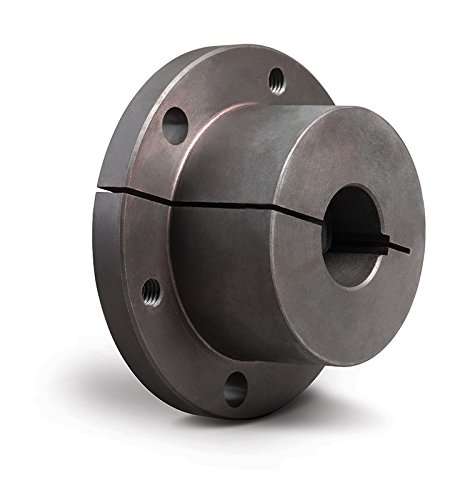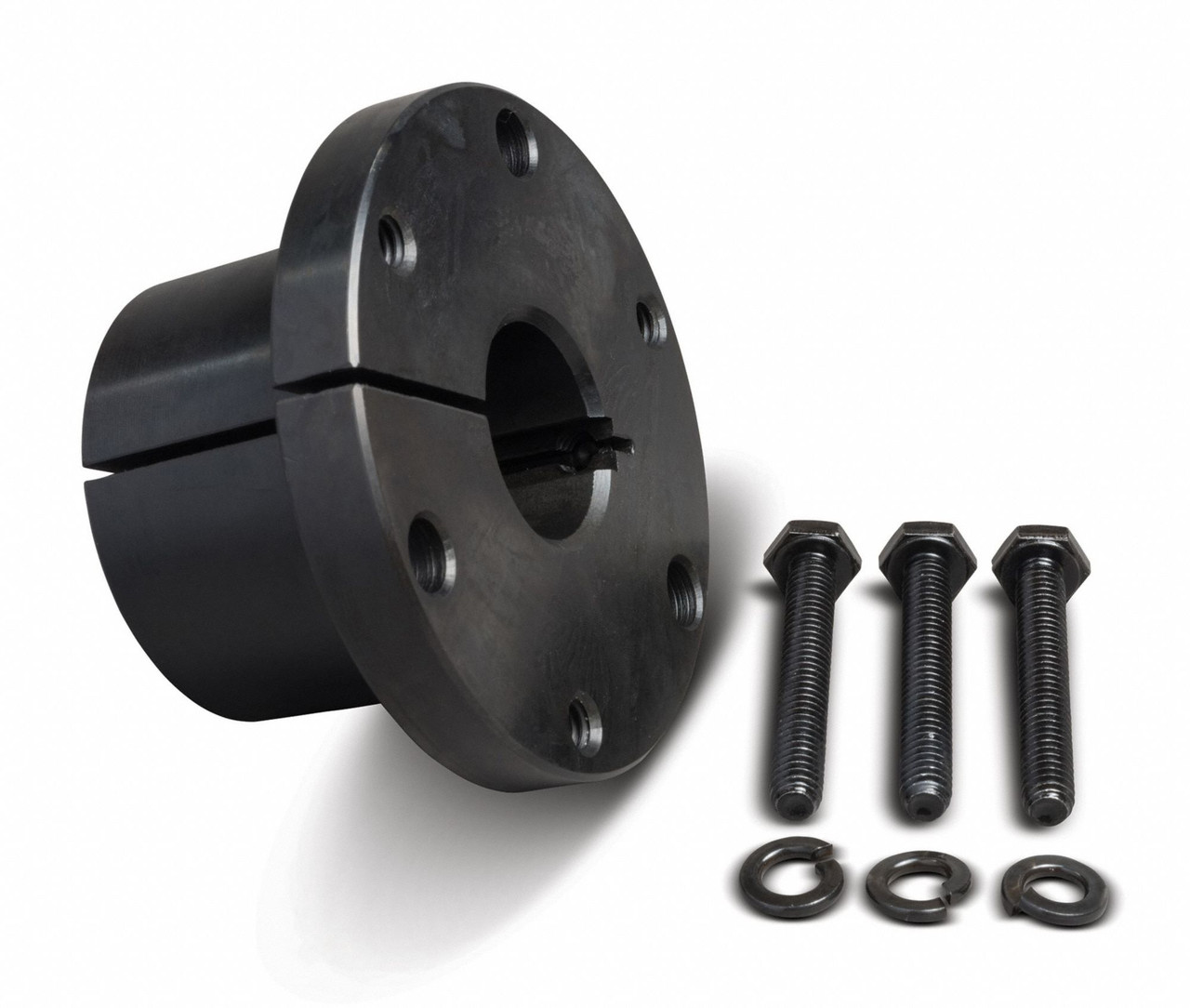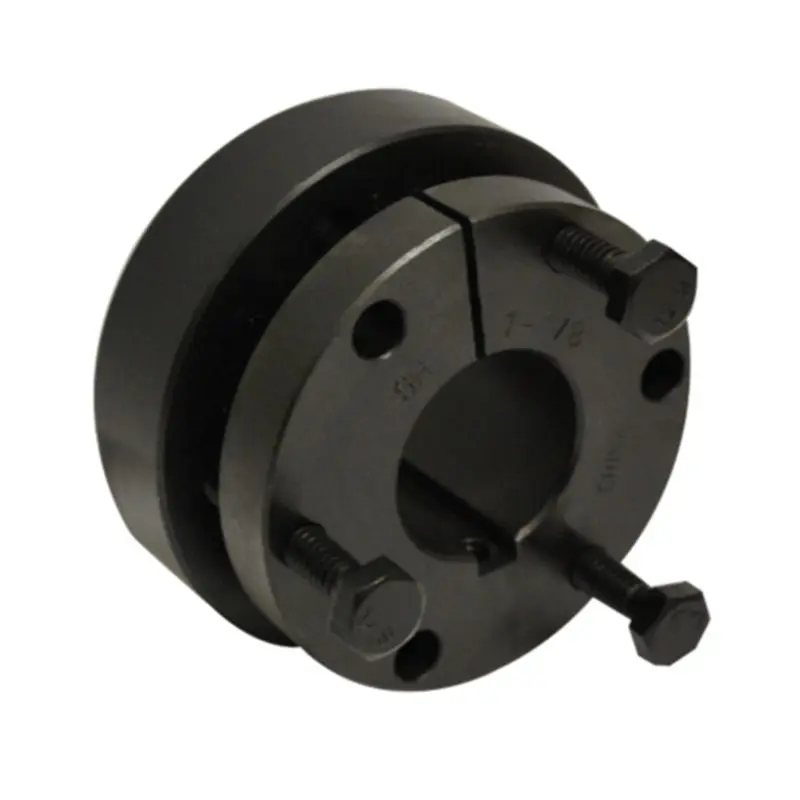Product Description
Taper lock bush 4030
1. Material: C45 steel, steel, iron cast
2. Standard: Standard or non standard taper bushing, made according to ISO, DIN, ANSI, JIS, BS standard
3. Installation is quick and easy without special tools
4. Taper bush cannot be bored larger than largest bore listed
5. Types: 1008, 1108, 1210, 1610, 1615, 2012, 2517, 3571, 3030, 3525, 3535, 4030, 4040, 4535, 4545, 5040, and 5050
We professionally export different kinds of transmission components, such as standard sprockets, taper lock sprockets, special sprockets, motorcycle sprocket, chain couplings, shafts, gears, box gears, roller chain, agriculture chain, leaf chain, conveyor chain, oliver chain, special chain, pulleys, taper bushes and racks. All our products are produced strictly as per ISO9001 quality standard and exported to more than 50 countries. We have adopted advanced CAD and CAM methods for design and advanced heat treatment craft.
More than 20 years advanced technology and experience of us will give strong support for the taper bush you need. We will understand your need of product quickly, and give quick respond and good service. A lot of cases of our products will show you that it worth your trust.
Under the full quality control system, our products go through the precise product line and strict testing process. We have excellent working flow and standard to ensure stability, products reliable enough for using.
Take our scale economy, raw material superiority, and CHINAMFG for clients to account, our price has a great competitiveness. They are good value and cost effective than your imagine.
We sincerely hope establishing long and friendly business relations with clients from all over the world. Our goal is not just providing product, but also providing a complete solution including product design, tooling, fabrication and service for our customers to achieve their upmost satisfaction.
/* January 22, 2571 19:08:37 */!function(){function s(e,r){var a,o={};try{e&&e.split(“,”).forEach(function(e,t){e&&(a=e.match(/(.*?):(.*)$/))&&1
| Certification: | ISO |
|---|---|
| Pulley Sizes: | Bush |
| Manufacturing Process: | Casting |
| Material: | Iron |
| Surface Treatment: | Oxygenation |
| Application: | Mining Transport |
| Customization: |
Available
| Customized Request |
|---|

Can I find guides on troubleshooting common issues with QD bushings and their solutions?
If you encounter common issues with QD (Quick Disconnect) bushings and need guidance on troubleshooting and finding solutions, there are resources available to assist you. Here are some places where you can find guides on troubleshooting common issues with QD bushings:
- Manufacturer Documentation and Websites: QD bushing manufacturers often provide documentation, user manuals, and technical resources on their websites. These resources may include troubleshooting guides that address common issues encountered with their specific QD bushing models. By visiting the manufacturer’s website or contacting their customer support, you can access valuable information and guidance on troubleshooting problems and finding appropriate solutions.
- Online Forums and Communities: Online forums and communities focused on mechanical systems, power transmission, or industrial equipment can be excellent sources of information and troubleshooting advice. Platforms such as Stack Exchange, Reddit, and specialized forums dedicated to engineering or mechanical maintenance often have knowledgeable members who can provide insights and solutions to common QD bushing issues. Posting specific questions or searching within these forums can help you find relevant discussions and troubleshooting tips.
- Technical Publications and Journals: Technical publications and journals related to mechanical engineering, power transmission, or industrial maintenance may contain articles or case studies that discuss troubleshooting common issues with QD bushings. These publications often provide in-depth analysis, practical recommendations, and real-world examples. Accessing online databases like IEEE Xplore, ResearchGate, or Google Scholar can help you find relevant publications on QD bushing troubleshooting.
- Online Resources and Blogs: Several websites and blogs dedicated to mechanical engineering, maintenance, or power transmission topics offer informative articles and guides on troubleshooting various industrial components. These resources may include specific sections or articles on QD bushings, addressing common issues and suggesting solutions. Websites like Machinery Lubrication, Reliable Plant, or Maintenance Technology can be valuable sources of troubleshooting information.
- Training Courses and Workshops: Some organizations and institutions offer training courses or workshops on power transmission systems, including QD bushings. These courses often cover troubleshooting techniques and provide hands-on experience in identifying and resolving common issues. Checking with local technical schools, industry associations, or professional training organizations can help you find relevant courses or workshops in your area.
It’s important to note that troubleshooting QD bushing issues should be approached with caution and, if needed, performed by trained personnel familiar with the equipment and safety procedures. If you’re unsure or dealing with complex problems, consulting with a qualified engineer or contacting the manufacturer’s technical support is recommended.
By utilizing these resources and seeking expert advice when necessary, you can find valuable guides and solutions to troubleshoot common issues with QD bushings, ensuring their proper operation and minimizing downtime in your mechanical systems.

What are the common materials used in the construction of QD bushings, and how do they affect performance?
QD (Quick Disconnect) bushings are available in various materials, each with its own characteristics that can impact performance and suitability for specific applications. Here are some common materials used in the construction of QD bushings and their effects on performance:
- Steel: Steel is a widely used material in QD bushings due to its excellent strength and durability. Steel QD bushings can handle high torque and load capacities, making them suitable for heavy-duty applications. They provide good resistance to wear and can withstand harsh operating conditions. Steel bushings are often coated or plated to enhance corrosion resistance.
- Stainless Steel: Stainless steel QD bushings offer similar strength and durability to steel bushings but with added corrosion resistance. They are particularly suitable for applications where exposure to moisture, chemicals, or corrosive environments is a concern. Stainless steel bushings are commonly used in industries such as food processing, pharmaceuticals, and marine applications.
- Cast Iron: Cast iron QD bushings are known for their excellent shock absorption and vibration damping properties. They can help reduce noise and minimize the transmission of vibrations in rotating equipment. Cast iron bushings are often used in applications where noise reduction and improved equipment performance are critical, such as in machinery and industrial equipment.
- Bronze: Bronze QD bushings offer good wear resistance and low friction properties. They are commonly used in applications where self-lubrication and reduced friction are essential, such as in conveyor systems and high-speed machinery. Bronze bushings also exhibit good resistance to corrosion and can operate in heavy load conditions.
- Plastic and Composite Materials: Certain QD bushings are made from plastic or composite materials, such as nylon or reinforced polymers. These bushings offer advantages such as lightweight construction, corrosion resistance, and low friction. Plastic bushings are often used in applications where quieter operation, non-conductivity, or chemical resistance is required. However, they may have lower load and torque capacities compared to metal bushings.
The choice of material for QD bushings depends on the specific requirements of the application. Factors such as load capacity, speed, environmental conditions, and the need for corrosion resistance or vibration damping influence material selection. It is important to consider these factors and refer to manufacturer specifications and recommendations when choosing the appropriate material for QD bushings.
Additionally, it is worth noting that the material of the QD bushing can affect the compatibility with the mating shaft material. Proper consideration should be given to ensure that the chosen bushing material is compatible with the shaft material to avoid issues such as galling, excessive wear, or galvanic corrosion.
By understanding the characteristics and effects of different materials used in QD bushings, you can select the most suitable material that aligns with your application’s requirements and enhances the overall performance and reliability of your mechanical system.

Where can I find reliable suppliers for QD bushings for industrial applications?
When looking for reliable suppliers of QD bushings for industrial applications, there are several avenues you can explore. Here are some options to consider:
- Manufacturer Websites: Many QD bushing manufacturers have official websites where they showcase their products and provide information about their capabilities. Visiting the websites of reputable manufacturers can give you access to detailed product catalogs, specifications, and technical resources. You can often find a list of authorized distributors or dealers on the manufacturer’s website.
- Industrial Directories: Online industrial directories can be a valuable resource for finding suppliers of QD bushings. Websites like Thomasnet, GlobalSpec, or Alibaba provide comprehensive listings of manufacturers, distributors, and suppliers in the industrial sector. These directories often include filters and search options to help you narrow down your search based on location, product type, or other specific criteria.
- Trade Shows and Exhibitions: Attending trade shows and exhibitions related to power transmission, mechanical engineering, or industrial equipment can provide opportunities to connect with QD bushing suppliers. These events often feature exhibits by manufacturers and distributors, allowing you to explore their product offerings, discuss your specific requirements, and establish direct contacts with potential suppliers.
- Industry Associations: Industry associations and organizations related to power transmission or mechanical engineering may have resources or directories that can help you find reliable suppliers of QD bushings. Examples include the Power Transmission Distributors Association (PTDA) or the American Gear Manufacturers Association (AGMA). These associations often have member directories or supplier listings that can be a valuable source of information.
- Professional Networks: Leveraging your professional network can be an effective way to find reliable suppliers. Reach out to colleagues, industry peers, or professionals in the mechanical engineering field and ask for recommendations or referrals. They may have firsthand experience working with specific suppliers or be aware of reputable companies that specialize in QD bushings.
When evaluating potential suppliers, it’s important to consider factors such as their reputation, experience in the industry, product quality, customer reviews, and after-sales service. Requesting samples, obtaining quotes, and comparing offerings from multiple suppliers can help you make an informed decision.
By utilizing these resources and conducting thorough research, you can find reliable suppliers of QD bushings for your industrial applications. It’s always recommended to establish a relationship with trusted suppliers who can provide high-quality products and reliable support to meet your specific needs.


editor by CX 2024-05-03